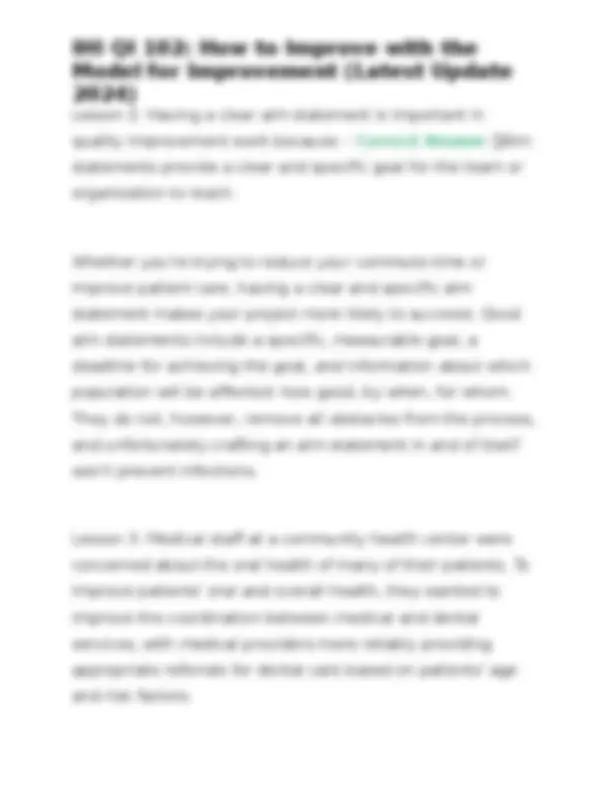














Study with the several resources on Docsity

Earn points by helping other students or get them with a premium plan


Prepare for your exams
Study with the several resources on Docsity

Earn points to download
Earn points by helping other students or get them with a premium plan
Community
Ask the community for help and clear up your study doubts
Discover the best universities in your country according to Docsity users
Free resources
Download our free guides on studying techniques, anxiety management strategies, and thesis advice from Docsity tutors
IHI QI 102: How to Improve with the Model for Improvement (Latest Update 2024)
Typology: Exams
1 / 20

This page cannot be seen from the preview
Don't miss anything!













Lesson 1: An orthopedic clinic in a busy metropolitan area would like to improve its patient scheduling process. More specifically, the clinic wants to improve its efficiency and the satisfaction of its patients. Applying the Model for Improvement to the clinic's improvement goal, which of the following is the most reasonable aim statement? - Correct Answer ✅Increase the number of patients reporting they are "very satisfied" with the clinic's scheduling by 50 percent within six months. An aim statement must specify "how good, by when." Improving patient satisfaction with scheduling is a reasonable goal. Answer D is best described as an opportunity statement, as it contains no specifics about how much the clinic must improve, nor by when. Answer C is more of a "change" statement than an aim statement. Lesson 1: An orthopedic clinic in a busy metropolitan area would like to improve its patient scheduling process. More
specifically, the clinic wants to improve its efficiency and the satisfaction of its patients. After assembling a team and working through the three questions of the Model for Improvement, the orthopedic clinic decides to implement an automated reminder phone call 24 hours prior to each clinical appointment. The clinic's improvement team hopes that this small change will improve scheduling. What is the team's next step? - Correct Answer ✅Test their change plan using the PDSA cycle. Once you have worked through the first three questions of the Model for Improvement — the questions about aims, measures, and changes — it's time to do a small test of change using the PDSA cycle. The clinic should have already developed their measures, and now is not the time for a break — because the hard work of improvement is just beginning!
Lesson 1: The Model for Improvement begins with three questions designed to clarify the following concepts: - Correct Answer ✅Aims, measures, changes The Model for Improvement begins with three fundamental questions about any given improvement, designed to address the aim (what are we trying to accomplish?), the measures to be used (how will we know a change is an improvement?) and the changes to be used (what changes can we make that will result in an improvement?). Lesson 1: When trying to improve a process, one reason to use PDSA cycles rather than a more traditional version of the scientific method (such as a randomized, controlled trial) is that: - Correct Answer ✅PDSA cycles provide a mechanism to adjust improvement ideas as the project progresses. PDSA cycles allow for rapid and frequent review of data and then adjusting the test of change based upon those findings. For example, if a new guideline that's meant to improve pneumonia care isn't working, PDSA cycles allow you to
change the guideline quickly and test its efficacy, rather than waiting until the end of a long study period. Lesson 2: Brenda, the office manager at a dental practice, noticed many patients were missing their appointments. With the support of her colleagues, she decided to conduct a small improvement project to improve the process for reminding patients of upcoming visits, with the goal of having fewer "no shows." Which of the following is the most effective aim statement for this project? - Correct Answer ✅Within three months, 90 percent of patients will show up for their appointments. Effective aim statements contain a time frame, a definition of the population to be affected, and specific, measurable goals. Answer B meets all three of these criteria. While answers A and C may be useful process changes to move toward the aim, they don't address Brenda's ultimate goal, which is to decrease the number of patients who miss appointments. Option D is not specific enough, and it is also less realistic.
appropriate aim? - Correct Answer ✅"It feels like a very meaningful project for both the patients and the practice." Writing an effective aim statement, especially when it comes to being specific about the improvement desired, can be surprisingly difficult. Dr. Berwick recommends choosing aims that feel meaningful for the improvement team. He also recommends selecting aims that are somewhat ambitious (i.e., they are not overly simple) and remind teams they can always adjust their aim statements as the project evolves. Lesson 2: An aim statement should include the following: - Correct Answer ✅Numeric goals, specific time frame, and the patient population or system affected Aim statements should specify measurable numeric goals, a time frame for attainment, and the group or system affected. Costs and team members, while important to the success of the quality improvement project, are not part of the aim statement itself.
Lesson 2: Having a clear aim statement is important in quality improvement work because: - Correct Answer ✅Aim statements provide a clear and specific goal for the team or organization to reach. Whether you're trying to reduce your commute time or improve patient care, having a clear and specific aim statement makes your project more likely to succeed. Good aim statements include a specific, measurable goal, a deadline for achieving the goal, and information about which population will be affected: how good, by when, for whom. They do not, however, remove all obstacles from the process, and unfortunately crafting an aim statement in and of itself won't prevent infections. Lesson 3: Medical staff at a community health center were concerned about the oral health of many of their patients. To improve patients' oral and overall health, they wanted to improve the coordination between medical and dental services, with medical providers more reliably providing appropriate referrals for dental care based on patients' age and risk factors.
Measures (both qualitative and quantitative) provide a way to gather information on the effects of the change you are testing. Without measures, you have no real way of knowing whether your change led to an improvement. Having good measures is critical if you wish to improve care and spread change throughout a system. Lesson 3: After six months of data collection and four linked PDSA cycles, a team is preparing to present the results of its improvement project. The graph looks like this so far: What additional information is most important for them to add to the graph to best explain the work they've done? - Correct Answer ✅Annotations to show when specific changes were tested When you go through multiple linked PDSA cycles in the course of a project, it's important to note which changes were tested and when so that you can make sense of the results. While costs are important, they won't tell you whether the changes led to improving the key outcome measure. P-values
showing statistical significance are more commonly used in quality research than in quality improvement. Lesson 3: As a nurse manager of a medicine unit in an academic hospital, you're aware that your unit has a high rate of patient readmissions. In fact, 36 percent of the patients discharged from your unit are readmitted to the hospital within 30 days. After reviewing the literature, you become aware that this rate is quite high compared to national standards. Working with other members of your unit, you develop a plan to call patients on the phone within 48 hours of discharge, with the aim of cutting readmission rates to 18 percent. Which of the following is the best example of a process measure that the team may collect as part of this improvement effort? - Correct Answer ✅The percentage of patients receiving a call within 48 hours of discharge Gathering data about process changes is important — otherwise, you won't know if you are consistently doing the
Coming up with a change that will address your problem is often one of the most difficult aspects of the change process. Brainstorming with colleagues may help, as can critical thinking and creative thinking about the problem at hand. In this case, simply moving to another clinic might reduce your frustration but will not help the clinic. Improving the scheduling software may be useful, but it's unclear at this point that technology is at the heart of the delays. Finally, the office staff very likely already know that patient follow-ups should be scheduled sooner, but some aspect of the process is making this difficult for them. Simply reminding them is unlikely to get results. Lesson 4: What's the main benefit of using change concepts to come up with improvement ideas? - Correct Answer ✅Using change concepts can help you develop specific improvement ideas that might not have occurred to you initially. Change concepts can help you develop new, specific ideas for change that could lead to improvement. They don't necessarily improve the likelihood that implementation of
these changes will go smoothly, however. Finally, testing the changes using PDSA cycles is still necessary! Lesson 4: As an office manager, you notice there's a high rate of "no shows" for appointments at your practice. People often tell you they scheduled the appointment far in advance, and simply forgot to go. You decide it's worth a try to improve this problem by sending reminders via text message. Which change concept are you using? - Correct Answer ✅Design Systems to Prevent Errors By sending out reminders, you are designing a system to help people avoid mistakes and prevent errors. The other options are all valuable types of change concepts, but they are not as relevant to this example. Lesson 4: Which of the following changes falls under the heading of "eliminating waste"? - Correct Answer ✅Clinicians type all notes directly into a computer rather than writing them in a patient's chart, thus saving paper.
place). Taking work home each night on a laptop computer simply shifts the work to home, rather than creating a more efficient work pattern. Lesson 4: Why might an improvement team consider collecting balancing measures? - Correct Answer ✅To make sure they didn't unintentionally introduce undesired changes Sometimes changes in one part of a complex system will lead to unintended additional changes in a different part of the system, like ripples in a pond. Balancing measures help teams monitor aspects of the system they don't want to damage accidentally. Lesson 5: You are working on shortening the time it takes patients with chest pain to get to the cardiac catheterization lab in your hospital. Your aim is to have 90 percent of patients brought to the lab within 45 minutes of arrival to the hospital. You decide to try a care protocol that another hospital in the area implemented with great success.
After several tests, you decide to try implementing a modified version of the protocol at your institution. Which of the following might you do within the "S" portion of your next PDSA cycle? - Correct Answer ✅Analyze information collected. "S" stands for Study. In this step you review the information collected during the "Do" step. Planning for implementation is part of the "Plan" step, and documentation of outcomes is part of the the "Do" step. Considering how to spread the change to another hospital is outside the scope of this PDSA cycle. Lesson 5: You are working on shortening the time it takes patients with chest pain to get to the cardiac catheterization lab in your hospital. Your aim is to have 90 percent of patients brought to the lab within 45 minutes of arrival to the hospital. You decide to try a care protocol that another hospital in the area implemented with great success. The care protocol was successful at the other hospital.
and realize that there are really multiple issues delaying patients' arrival to the catheterization lab. Specifically, the emergency department needs to notify the lab staff in advance, but this communication rarely happens. Further, the schedule that the emergency department uses to contact the lab staff is riddled with errors. Based on the recommendations in this lesson, what should you do next? - Correct Answer ✅Work on improving both the schedule and communication at the same time. You should start testing changes to both processes and run the tests concurrently. That way you can see how all the required changes work together. Remember, your goal is to bring knowledge into action—not to discover the single change that works best. Lesson 5: Which of the following statements is true? - Correct Answer ✅While not all changes lead to improvement, all improvement requires change.
All improvement requires change — but unfortunately, not all changes lead to improvement. It is precisely for this reason that after you test a change, you should study the results to determine whether you're closer to accomplishing your goal. Lesson 5: Starting with small tests of change: - Correct Answer ✅Improves the likelihood of buy-in from clinical and administrative staff members Linking tests of change — with one test concluding and the next beginning at the same time, but this time on a larger scale or with a different scope — allows you to build support for your project. Each successive test is a way to demonstrate to key stakeholders that their input has value and that the project may actually lead to improvement. However, it's not necessary to seek consensus among stakeholders before testing changes.